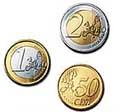Allergy to the euro!

With the euro we have arrived the case that has just emerged in its environment. Several Austrian dermatologists have indicated that the new coin can produce allergies to citizens, since its composition contains nickel sufficient to produce contact dermatitis.
About 10% of the population is allergic to nickel. This causes the skin to dry, irritate, and generate itching. But to do this, you must be in contact with the currency for a long time. The problem of the use of nickel in the manufacture of coins is not new, since for a long time nickel alloys have been used for the manufacture of high value coins to avoid fraud. In addition, according to the European Union's technical report, coins have passed the allergy test and hypoallergenic products have been produced. But recent studies indicate that the euro has an amount of nickel higher than usual.
Richar Rycroft, of the St John's Dermatology Institute in London, commented that the government is lying. In his opinion, it makes no sense to say that they are hypoallergenic if the investigations have revealed otherwise, and the merchants and bus drivers may have problems, as well as those who have custom to carry the coins in their pocket, since they can cause eczema in the legs.
Although Swedish scientists have requested that all coins be made without nickel, the European Central Bank has decided to use this element only in higher value coins. Coins of 1 to 50 cents will not carry nickel, but they will carry coins of one and two euros.
So, where do you take the coins from now on! Or, at least, who can, use only tickets!
Buletina
Bidali zure helbide elektronikoa eta jaso asteroko buletina zure sarrera-ontzian











